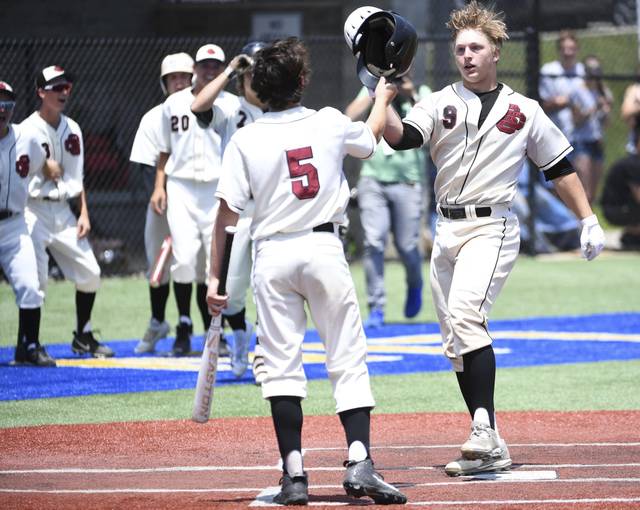https://triblive.com/sports/high-school-college-players-feel-effect-of-mlb-draft-change/
High school, college players feel effect of MLB Draft change

If things were normal, Serra Catholic catcher Mark Black would be about two weeks into his senior season, wowing scouts, fans and teammates with his daily power displays as he tried to boost his stock for the MLB Draft.
If things were normal, Pitt outfielder Nico Popa would be in the thick of the ACC schedule, showing off his all-around game and vying to become a high-end draft pick.
Things, of course, are far from normal.
Like many Americans, high school and college baseball players across the country are stuck inside because of the coronavirus pandemic. The PIAA is holding out hope it can salvage a spring sports season, but that becomes more unlikely each day. The NCAA canceled all spring sports March 12.
MLB moved its draft from June to July and likely will shorten it from 40 rounds to five or 10. That means players who were near-locks to get picked during other years — such as Black and Popa — could miss out.
“It’s a shame what’s going on right now,” Serra Catholic coach Brian Dzurenda said.
Black, the reigning Trib HSSN Player of the Year, was projected to go in the top 10 rounds, scouts told Dzurenda. The 5-foot-10, 215-pound Black hit .521 last season with a WPIAL-best 14 homers to go with 44 RBIs in leading Serra to the Class AA state championship. The St. John’s recruit also made a name for himself at national showcases over the summer. But the reduction in rounds and likelihood of no high school season are two major variables.
“I think not having a season will affect things somewhat, especially because northeastern baseball didn’t really get to play but some of the southern schools did, so that could affect it,” said Black, who wouldn’t be draft-eligible again until 2023 if he went to St. John’s. “But I know I did all the big events over the summer, so all the scouts know who I am.”
Said Dzurenda: “He’s a man playing with boys. He’s the best high school baseball player I’ve seen in 22 years, and I’ve seen some great ones.”
Scouts had been reaching out to Dzurenda on a near-daily basis this spring, and Serra moved its games to 4:30 p.m. so scouts could watch batting practice. Now? Dzurenda and Black must wait.
“Mark is going to end up being drafted,” Dzurenda said. “If it’s not this year, then in another year. He’s going to be a pro. That’s the bottom line.”
To stay or to go?
Popa, a Seton LaSalle graduate, played 16 games this season before the Panthers’ season ended abruptly. He hit .275 with six RBIs and five stolen bases a year after earning second-team All-ACC honors.
The good news for Popa is if he falls out of the draft, the NCAA on Monday granted seniors who played spring sports an extra year of eligibility.
“I’m really excited and grateful that I’m able to go back another year at Pitt,” he said earlier this week. “But I still need to discuss with the coaches and academic advisers about how that’s going to work.”
His other option if he goes undrafted this year would be to sign with an MLB team as a college free agent. There are pros and cons with that choice, too, because the maximum signing bonus would be $20,000. In previous years, there was no cap. (The main reasons for the shortened draft and bonus limits are to save MLB teams money because of the lost revenue from the season shutdown). Another factor is MLB’s proposal to eliminate 42 minor league teams by 2021.
“At the end of the day, with the cuts coming down the pipe in minor league baseball, those (roster) spots are going to become harder and harder for student-athletes,” said Pitt coach Mike Bell, who mentioned outfielders Kyle Hess and Ron Washington Jr. along with pitcher Mitch Myers as his other players receiving the most draft interest entering the season.
“I think there will be more mid-major players and juniors being fine with that ($20,000 rather than returning) because they’ll think their opportunity will be closing. There aren’t going to be as many jobs available.”
The short of it
Black is among hundreds of high school seniors who might get squeezed out of a five- or 10-round draft. Black, a straight-A student, committed to the Red Storm before his sophomore year, but other high schoolers likely were banking on immediately going pro.
They might be left scrambling to make college plans, but Bell doesn’t see that as a bad thing.
“If a high school student-athlete would have been drafted in the 15th to 20th round in years past and now needs to go to college because he’s not drafted, it’s probably the best thing for him when you look at the percentage of guys out of high school who make it to the big leagues,” Bell said.
“It’s a small percentage. Not to say the round next to your name has everything to do with it, but there’s no doubt a first-rounder or second-rounder has a higher percentage and is given more opportunities. But those high school student-athletes who aren’t going to be drafted this year, maybe it’s a blessing to them because they get to experience college and the opportunity to pursue a college education.”
Bell expects a shorter draft to favor the Power Five conference players rather than high schoolers or junior college players because of the increased exposure, but he doesn’t expect elite prep talent to slip through the cracks.
“If a high school student-athlete is talented enough to get drafted, nowadays he’s been seen. He’s been overanalyzed,” Bell said. “There are organizations now that say even with us not playing games out there now, whether they’re high school or college, they could have the draft tomorrow.”
Still a one
One of those high schoolers who doesn’t need to worry about exposure is West Allegheny’s Austin Hendrick. The uber-talented senior outfielder, a Mississippi State recruit, has been on many scouts’ radar since he was an eighth-grader.
Most rankings peg him as one of top two high school hitters available, and several mock drafts predict the Pirates will take him seventh overall.
You wonât see this ball land . . . because Austin Hendrick hit it over the batterâs eye.No. 2 high school prospect in the country in Baseball Americaâs 2020 draft rankings. Vicious bat speed and power.
Full Top 100 here: https://t.co/LyC4vWqxJq pic.twitter.com/uklMJ8XH7I
— Ben Badler (@BenBadler) December 27, 2019
Not getting to play as a senior likely won’t affect Hendrick’s stock, but he was hoping to work on a retooled swing in which he replaced a toe tap with a more traditional stance featuring a leg kick, according to coach Bryan Cornell.
“By all accounts, Austin has done enough with his body of work within the summer that it really won’t affect things except for maybe a few picks,” Cornell said. “I think they’ve seen enough of Austin to realize his potential.
“Austin will be fine, but you feel for all these players who won’t have their junior, senior seasons that could affect their draft status and could affect being seen by college coaches.”
Copyright ©2025— Trib Total Media, LLC (TribLIVE.com)
